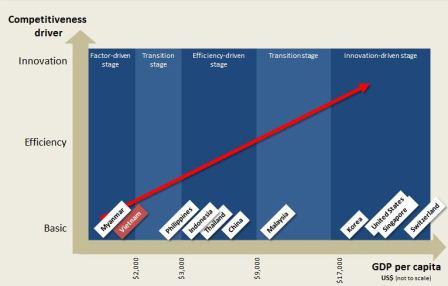Nguyen Quang Vinh, MBA
Secretary-General of VBCSD
Low productivity is the main factor hampering competitiveness - the key to economic growth. Vietnam is at risk of being left behind in the economic development race if its productivity disadvantages are not addressed.
Productivity and competitiveness
First of all, we need to understand what productivity is and how important it is to competitiveness. Productivity is an average measure of the efficiency of production, expressed as the ratio of output to inputs used in the production process. Inputs may be work hours (labour productivity) or all production factors, including labour, machinery, materials and energy. Productivity determines the degree of efficiency (efficiency of using capital and production processes, improving product quality) and innovation (developing sophisticated products, services, and production and business models with high content of intelligence). According to the World Economic Forum (WEF), innovation and efficiency are respectively placed on the two top positions of importance out of three factors that lead competitiveness (Figure 1). Thus, productivity is the key to competitiveness.
Competitiveness-driven factors (Source: World Economic Forum)
Vietnam’s Productivity: Current condition, Causes and Challenges
In its latest report, the Asian Productivity Organisation (APO) rated Vietnam at the low of Asia - Pacific in terms of productivity. Accordingly, Vietnam’s productivity is a fifteenth that of Singapore, a fifth of Malaysia, and two fifths of Thailand. According to the Global Competitiveness Report 2014-2015 by the World Economic Forum, Singapore ranked second in competitiveness, followed by Malaysia (20) and Thailand (31). Vietnam was placed 65th out of 144 economies. Hence, Vietnam’s productivity and competitiveness were quite low in the region. This was not a surprise. Over the past years, Vietnam has primarily competed by its low-cost labour and cheap materials (basic factors), a driving factor of competitiveness with the least importance (Figure 1), while Thailand and Malaysia have built up their competitive advantages by continuously improving products and services, and Singapore has long competed by its characteristic products and services using a very high technological level. Relying too much on cheap labour and low-cost input advantages in the long term causes local businesses to make light of improving strategy planning, governance, scientific and technological application to production and business, worker expertise improvement, and capital efficiency, resulting in lower labour productivity in Vietnam than other countries in the region. As Vietnam has become a low middle-income country, its traditional competitive advantages mentioned above will gradually disappear, and raising its low productivity will be a major obstacle for Vietnam to attract investment capital and advance international integration. This may lead us into the so-called middle-income trap. Therefore, in the near future, enhancing productivity must be a key drive to promote the competitiveness and economic development of Vietnam.
Besides, increasing capital efficiency is also important. According to the McKinsey Global Institute (MGI), the average capital efficiency ratio for Vietnamese State-owned enterprises (SOEs) is 1.62, meaning that they need US$1.62 in capital to generate one additional dollar of revenue. That compares with the average ratio calculated in Vietnam for multinational corporations of 69 cents and for private companies as a whole of just 47 cents - a wide gap in financial capital efficiency. The gap may be worse if the efficiency of natural and social capital is taken into account. In fact, very few Vietnamese businesses pay attention to the productivity of these two types of capital, although they are as important as financial capital. To measure the productivity of natural capital and social capital, the most effective way is to make sustainability reports. Currently in Vietnam, Bao Viet Holdings and Hoang Anh Gia Lai Group are among the very few Vietnamese companies to implement this good practice.
How to improve productivity?
At the national level, Vietnam needs a specialised agency responsible for working out long-term strategies and roadmaps, set targets, build national action programmes on productivity improvement for Vietnam. To do this, Vietnam should refer to the experience of other countries with high productivity like Switzerland, Singapore and Japan. At the same time, the agency will coordinate with relevant agencies to monitor the progress of action programmes, as well as aggregate results to periodically report to the Government.
To raise productivity for businesses, VCCI, or to be precise, the Office for Business Sustainable Development, will cooperate with domestic and foreign partners like the Vietnam National Productivity Institute and the Asia Productivity Organisation (APO) to work out an action programme to improve productivity for Vietnamese enterprises in the 2015-2025 period, with a vision to 2035. In the near term, we will conduct surveys and research on productivity of some key economic sectors in Vietnam like agriculture, industry and services so as to portray the accurate picture of productivity of companies in these sectors, including statuses, causes and factors affecting the productivity, to outline measures and specific goals for the purpose of productivity improvement for enterprises. We will carry out a series of business support activities like media, training, consulting and technical support. Good pilot results will be applied in other economic sectors of Vietnam.
One of major contents of the abovementioned action programme is green productivity strategy for businesses. This strategy combines appropriate management tools, techniques and technologies to increase production efficiency and reduce input and energy consumption, thus lowering production costs and environmental remediation costs. According to the findings by Vietnam Business Council for Sustainable Development (VBCSD), the application of green productivity to cement manufacturing in Vietnam will help save 2.5 million tonnes of coal dust mixture, valued VND5,295 billion and reduce greenhouse gas emissions, equivalent to over 6.743 million tonnes of carbon dioxide. The effective implementation of the Action Programme for Vietnam Green Growth Strategy, approved by the Prime Minister in 2014, will help businesses manage, measure and improve their green productivity through their business operations, thus contributing to sustainable growth of Vietnam's economy in the future.
